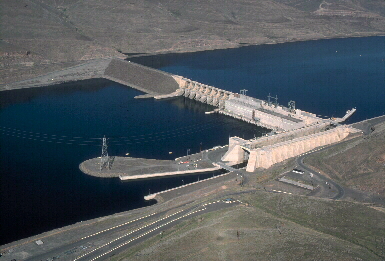forum
library
tutorial
contact

Report Shows Energy Efficiency Efforts in 2010
Marked Biggest Megawatt Savings Gain in 30 Years
by Staff
Columbia Basin Bulletin, October 14, 2011
|
the film forum library tutorial contact |

|
Report Shows Energy Efficiency Efforts in 2010
by Staff
|
(bluefish notes: 254 aMW is roughly equivalent to the power output of one Lower Snake River dam.)
 Increased conservation during 2010 by Pacific Northwest electricity users saved 254 average megawatts, the equivalent annual power use of 153,900 homes, according to the annual "Utility Conservation Achievements Report" released this week by the Northwest Power and Conservation Council and Regional Technical Forum.
Increased conservation during 2010 by Pacific Northwest electricity users saved 254 average megawatts, the equivalent annual power use of 153,900 homes, according to the annual "Utility Conservation Achievements Report" released this week by the Northwest Power and Conservation Council and Regional Technical Forum.
That's the biggest one-year gain since regional energy-efficiency programs began more than 30 years ago.
The 2010 savings bring the region's total since 1978, when energy-efficiency programs began in the Northwest, to 4,600 average megawatts - enough power for four cities the size of Seattle. Those total savings equal what was needed in 2009 to power the states of Idaho and Montana combined.
The measures implemented in 2010 saved Northwest electricity ratepayers $135 million and will produce the same amount of savings every year for the next 15-20 years, at least.
"The efficiencies you make in one year continue to save energy" in succeeding years, said Terry Morlan, the Council's Power Planning Division director. The report was previewed by NPCC energy policy analyst Gillian Charles, conservation resources manager Tom Eckman and senior power division analyst Charlie Grist Wednesday during the Council's meeting in Portland.
Overall utilities spent about $389 million to achieve the $135 million in savings in 2010, but the investments made last year will continue to bring savings in the years to come and very soon pay for themselves.
The Council and RTF, an advisory committee established in 1999 to verify and evaluate electric energy efficiency savings, calculated the savings from the results of a survey of the region's electric utilities, the Energy Trust of Oregon, the Northwest Energy Efficiency Alliance, and the Bonneville Power Administration.
The fiscal year/calendar year 2010 survey represents the activities of 76 utilities serving over ninety-eight percent of the region's retail electricity sales. The RTF has not independently verified the reported savings and expenditures.
The 2010 savings surpassed the Council's target for the year in its Northwest Power Plan, 200 average megawatts, by 25 percent. Regional energy conservation achievements have surpassed power plan targets in every year since 2005.
The Council revises its power plan every five years, forecasting energy demand 20 years into the future and recommending a mix of electricity resources to meet that demand. The current plan is for the years 2009-2029.
To see summaries and individual utility reports for 2010 go to: http://www.nwcouncil.org/energy/rtf/consreport/2010/
The savings occur when electricity is used more efficiently - using less power to accomplish the same tasks. Those saving can be gain by replacing incandescent light bulbs with compact fluorescents or LED bulbs, which produce the same amount of light with less electricity, in homes, businesses, and industries, and also by improving insulation or replacing windows in buildings so less power is needed to heat or cool them.
Replacing inefficient motors, pumps, furnaces, and other types of machinery also yields energy savings, as do changes in how much energy is used during the day, such as through programmable thermostats. The RTF has identified 90 measures that improve electric energy efficiency.
Other highlights include:
The Northwest Power and Conservation Council is a compact of the states of Idaho, Montana, Oregon, and Washington and is directed by the Northwest Power Act of 1980 to prepare a power plan to assure the Northwest region an adequate, efficient, economical, and reliable electricity supply and a companion program to protect, mitigate, and enhance fish and wildlife of the Columbia River Basin affected by hydropower dams.
Related Pages:
Conservation Play Key Role in Meeting NW's Energy Needs by Matthew Presch, The Oregonian, 2/10/10
How Conserving Energy Saves Money Now and in the Future by Emily Florez, KIDX, 12/11/9
Power from Nothing: Energy Plan Stresses Conservation by Don Jenkins, The Daily News, 10/25/9
Conservation Could Provide 85 Percent of Power by Nicholas Geranios, Seattle Times, 7/29/9
Efficiency and Conservation Drops Energy Demand by 2020 by Earth Policy Institute, Environmental News Net, 1/6/9
BPA: Conservation Saved Enough to Power Small City by Michael Jamison, Missoulian, 1/20/8
BPA Saves 850 MW in Conservation by Staff, BPA Journal, 8/5
Power Council says Conservation is Key by Michael Jamison, Missoulian, 12/12/4
learn more on topics covered in the film
see the video
read the script
learn the songs
discussion forum
